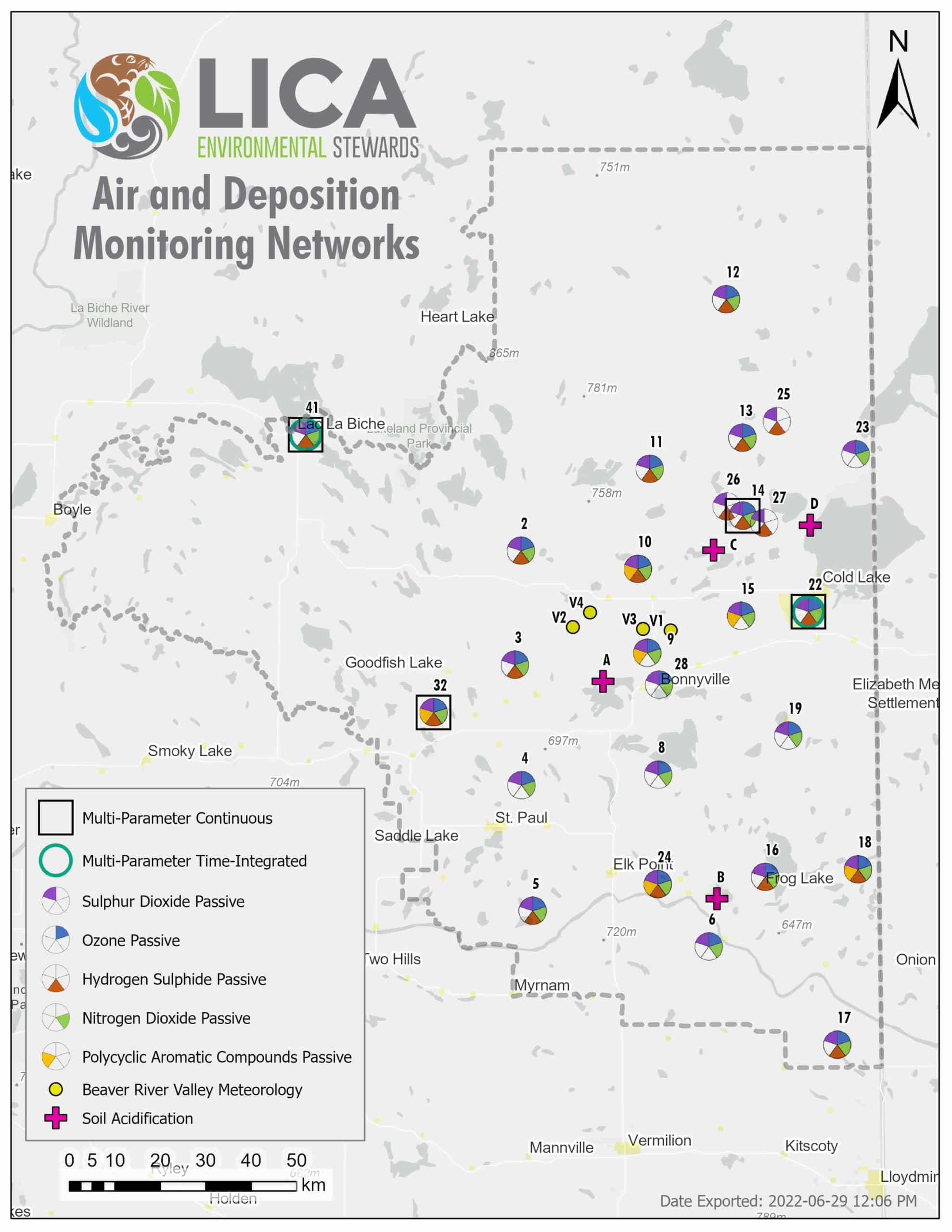REGIONAL MONITORING PROGRAMS OVERVIEW
Continuous Monitoring Continuous monitoring equipment provides an almost instantaneous measurement of ambient concentrations for several pollutants. These include hydrocarbons, hydrogen sulphide, total reduced sulphurs, oxides of nitrogen, ozone, particulate matter and sulphur dioxide as well as meteorology. This monitoring method can provide a measurement of pollutant concentration for intervals as short as one minute, although the most commonly reported sampling interval is one hour. Continuous monitoring is used to determine the Air Quality Health Index (AQHI).
Time-Integrated Monitoring In some cases, a more detailed investigation is needed to determine what pollutants are present in the air. In these situations, time-integrated monitoring is used and involves collecting of samples over a period of time commonly ranging from one to 24 hours. These samples are then analyzed at a laboratory to determine air pollutant concentrations. Time-integrated monitoring is often used to identify concentration and composition of particulate matter and hydrocarbons in the air.
Passive Monitoring is named for the technique used to collect samples. This method is often used in rural and remote areas and requires no power to operate. Pollutants are collected on reactive surfaces, which are then sent to the laboratory for analysis. Passive monitors usually sample for an entire month. Analysis provides a monthly average for pollutants being monitored.
Soil Acidification Monitoring for changes in forest soils, specifically changes caused by acidifying substances, is an important part of understanding the effects of atmospheric deposition. This type of monitoring involves collecting a sample of soil and sending it to a laboratory for analysis. Soil acidification parameters are soil attributes that can be directly affected by acidic inputs, and which in turn could affect other components of the ecosystem. These attributes include pH, exchangeable base saturation, aluminum, and base cations.
Beaver River Valley Meteorology Monitoring Project is a focused study that aims to understand the meteorological patterns of the Beaver River Valley and the role these patterns have in potentially affecting air quality in the region. The underlying assumption of the project is that valleys are deep and steep, and are therefore likely to generate flows, drawing air from above the valley ridge and into and along the river valley system. This small network of monitoring stations collected data on wind speed, wind direction, temperature, and relative humidity.
← Click on the ADMPEC icon to find more information about the Acid Deposition Monitoring Program Expansion Committee

| 2 | Sand River | 12 | Foster Creek | 23 | Medley – Martineau |
| 3 | Therien | 13 | Primrose | 24 | Fort George |
| 4 | Flat Lake | 14 | Maskwa | 25 | Burnt Lake |
| 5 | Lake Eliza | 15 | Ardmore | 26 | Mahihkan |
| 6 | Telegraph Creek | 16 | Frog Lake | 27 | Mahkeses |
| 8 | Muriel – Kehewin | 17 | Clear Range | 28 | Bonnyville |
| 9 | Dupre | 18 | Fishing Lake | 32 | St. Lina |
| 10 | La Corey | 19 | Beaverdam | 41 | Lac La Biche |
| A | Moose Lake Soil Plot | V1 | Beaver River Valley Site 1 | ||
| B | Whitney Lakes Soil Plot | V2 | Beaver River Valley Site 2 | ||
| C | Tucker Lake Soil Plot | V3 | Beaver River Valley Site 3 | ||
| D | Cold Lake Fish Hatchery Soil Plot | V4 | Beaver River Valley Site 4 |
NEAR REAL-TIME AIR QUALITY MONITORING DATA
For near real-time air quality monitoring data in the LICA region, click here.
AIR QUALITY HEALTH INDEX
The Air Quality Health Index is a way of describing our outdoor air quality. Click here for more information on how Alberta Environment calculates the Air Quality Health Index. For near real-time AQHI cross Alberta, please click here.
Apr 24, 2024, 6:00pm
Apr 24, 2024, 6:00pm
Formerly Maskwa
Apr 24, 2024, 6:00pm
Apr 24, 2024, 6:00pm
The Air Quality Health Index (AQHI) helps you understand what the air quality around you means to your health. The AQHI is a tool that relates the air quality outside to your health, using a scale from 1 to 10. The lower the number, the lower the risk. The AQHI is determined for locations across Alberta; current values and forecasts can be on this website.
LICA’s Tamarack Monitoring Station is identified as “Marie Lake” on the above website.

Air Quality Health Index Display
To help educate the public on air quality, LICA installed an air quality display in the Cold Lake Energy Centre and the Bonnyville Library. To read more about these displays, please click here.
NEAR REAL-TIME PARTICULATE MATTER (PM) DATA
LICA recently installed a PurpleAir device at the Cold Lake air monitoring station. PurpleAir devices monitor particulate matter (PM), which is the term for the mixture of solid particles and liquid droplets found in the air. Our aim with the PurpleAir devices is to ‘cast a wider net’ and bring cost-effective, accessible air quality monitoring data and information to smaller communities and settlements throughout our region. Cold Lake was chosen as our first deployment location because it allows us to compare PurpleAir data to our ‘standard’ methods for monitoring particulate matter which are in use at this location. LICA intends to deploy more PurpleAir devices in other communities throughout the region in 2020. To find the data from the PurpleAir device in Cold Lake (along with all of the other PurpleAir monitoring locations across the globe!), please click here.
Stop Needless Idling Campaign
 In partnership with Alberta Airsheds Council, LICA launched an Alberta-wide Stop Needless Idling campaign. This educational campaign describes two major benefits of stopping needless idling, including keeping the air healthy and saving fuel and money. Drivers are asked to pledge to idle for 60 seconds or less when they are parked. Drivers who pledge will be entered into LICA’s hoodie prize draw. For more information about the campaign, and to do your part and PLEDGE to Stop Needless Idling please visit https://www.albertaairshedscouncil.ca/60-seconds.
In partnership with Alberta Airsheds Council, LICA launched an Alberta-wide Stop Needless Idling campaign. This educational campaign describes two major benefits of stopping needless idling, including keeping the air healthy and saving fuel and money. Drivers are asked to pledge to idle for 60 seconds or less when they are parked. Drivers who pledge will be entered into LICA’s hoodie prize draw. For more information about the campaign, and to do your part and PLEDGE to Stop Needless Idling please visit https://www.albertaairshedscouncil.ca/60-seconds.
Reports
LICA generates different reports to provide air quality information to our stakeholders.